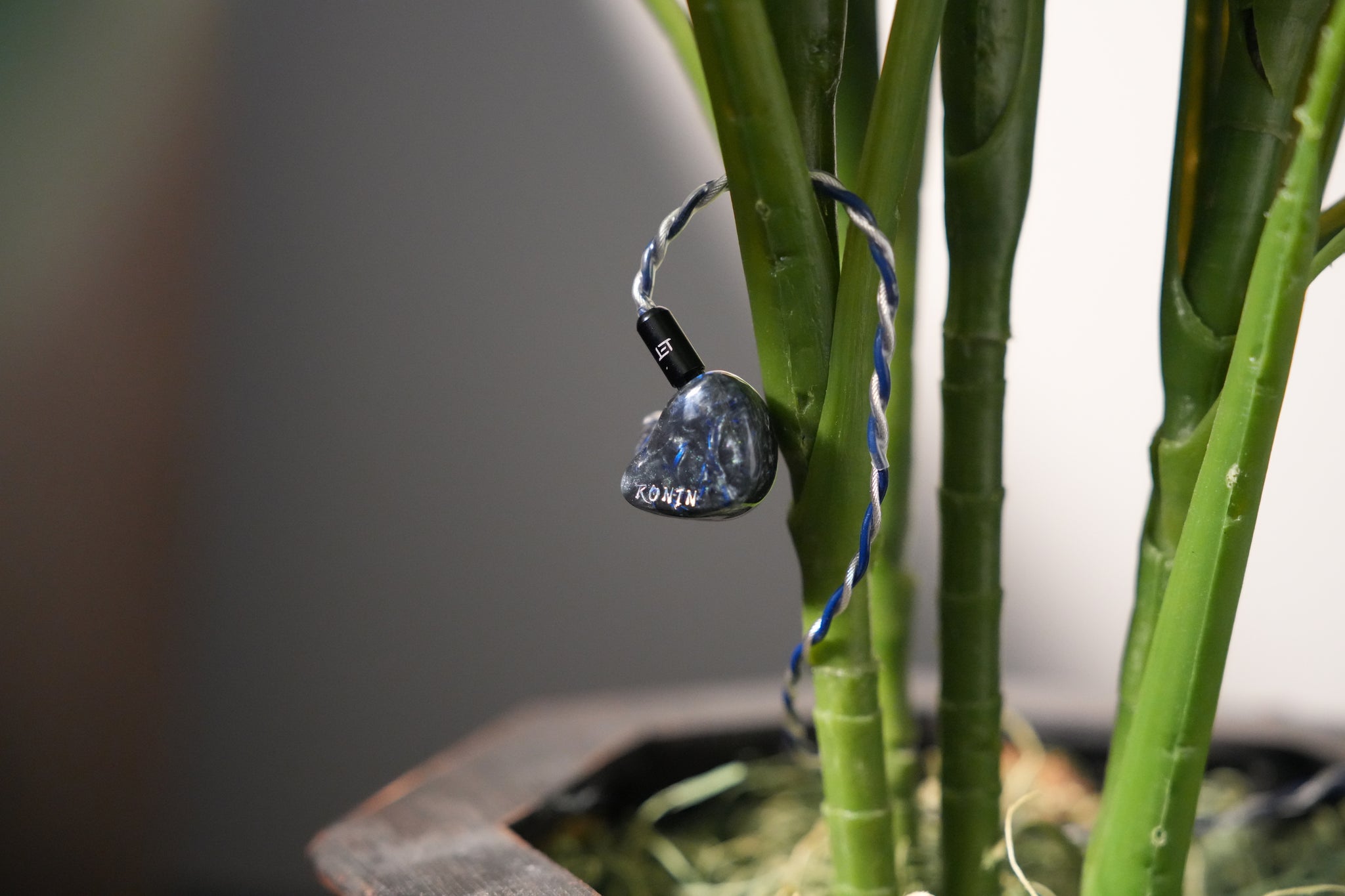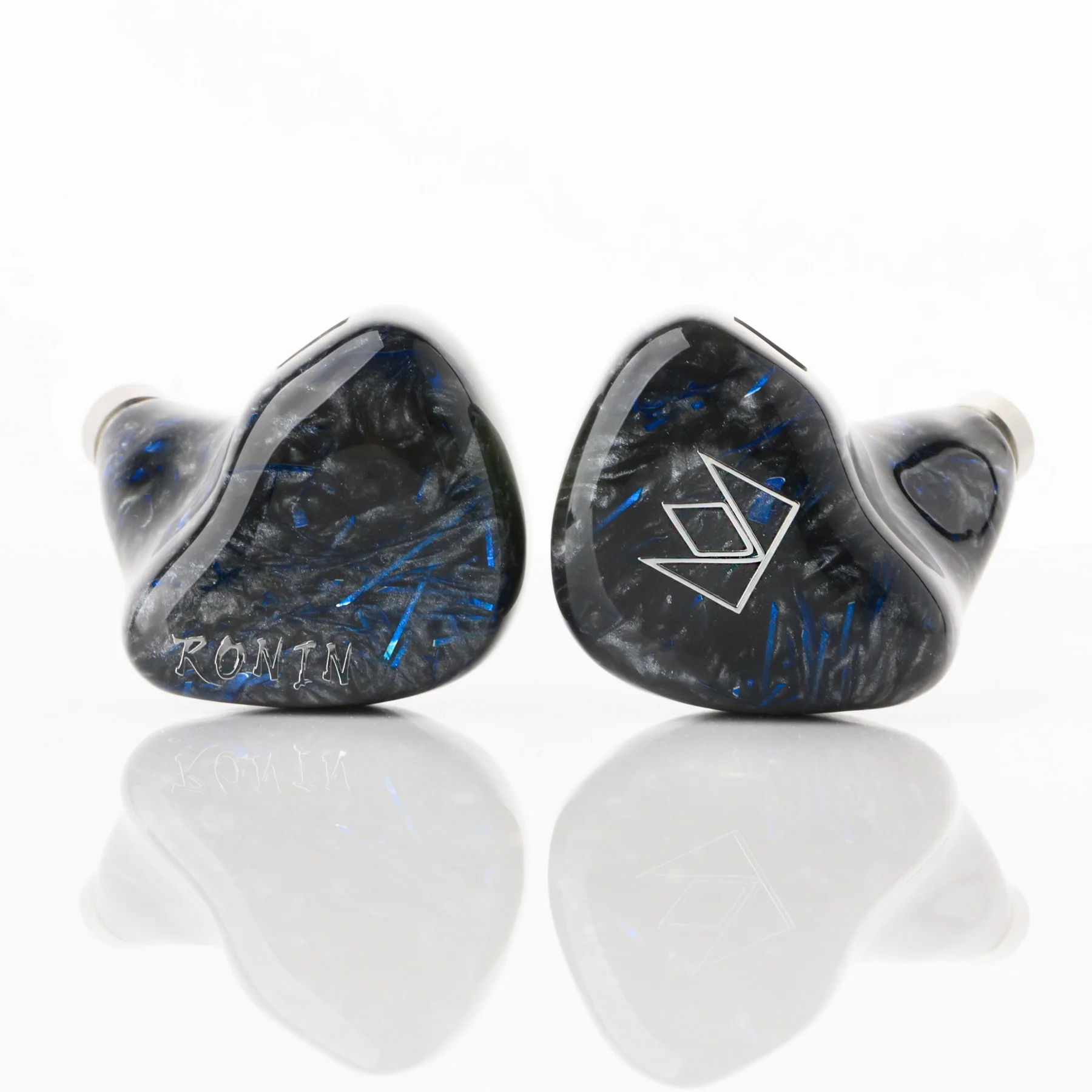99.990.000 ₫
Còn hàng
TỔNG QUAN
THÔNG SỐ KỸ THUẬT
Upon removing Ronin from its packaging, the first thing I noticed was how the pictures don’t do it justice. This is an absolutely gorgeous IEM with a finish worthy of a top of the line IEM. It’s definitely quite large, and the insertion is moderately deep, so if you have smaller ears, it might be challenging to get a good fit. Noble provides a selection of silicone and foam tips that should help you find the perfect combination for a good seal and fit.

The cable was specially designed by Eletech specifically for Ronin and uses four cores. Two of the cores are silver plated copper, and the other two are a mix gold plated copper and OCC copper strands. The cable has a smooth luxurious feel, and it has very little memory cable and is resistant to tangling. You can also expect Noble’s typical excellent protective travel case that they provide with their flagship IEMs.
Ronin is highly revealing, with incredible detail and microdynamics that deliver a vivid, lifelike reproduction of music that makes you feel like you could reach out and touch the instruments. The emphasis is clearly on delivering a reference sound that’s bright, but not so much analytical, instead delivering emotion through immersive imaging and visceral highs.
With Ronin’s balanced armature based low-end, you get excellent speed and strong texture. And while it doesn’t have the impact of a dynamic driver bass, there are other physical characteristics it provides, like the pluck of the bass or the sense of the tactile nature of the skin of a drum or timpani head.

The mids are clean, detailed, and transparent. You get absolutely top tier detail retrieval coupled with strong layering and separation. The timbre is just on the bright side of natural, but doesn’t have any sharp or tinny overtones. The treble provides definition and a great sense of air. Ronin offers excellent resolution and speed in a highly technical treble delivery.
The soundstage is wide and three dimensional, and the whole presentation of the stereo image is immersive, with holographic imaging, and a real sense of putting the listener on the stage or in the studio with the performers.
I tried a few different DAPs, and found the character of Ronin to be a little bright and sometimes bass-lite. The DX320 and Astell&Kern Acro CA1000 were my first two references, and the CA1000 slipped into some fatiguing tones from time to time. When I switched to the Astell&Kern SP3000 it seemed to balance things out perfectly, adding just a hint of support in the bass. Along with that it manages the challenging upper range frequencies brilliantly without losing the character of Ronin’s intense treble.
The first thing I noticed on Ed Sheeran’s “Thinking Out Loud” is how incredibly tactile the percussive aspect of the strumming was on the guitar. And that physical feeling extends to the bass piano and drums as well. While Ronin manages to deliver some impact with the kick drum, it’s other aspects like the snap of the snare that really add to the experience. Along with it, the separation between instruments almost transforms the whole song to make you feel like you’d never even listened to it before.

The combination of quality production and virtuoso musicianship on Hiromi’s “Wanderer” has made it one of my favorite reference tracks for jazz and acoustic instruments. Ronin provides an amazing imaging experience, with a natural sense of balance with the ensemble, and clear placement of each instrument. Ronin provides the sort of imaging that puts you – not in the front row – but in the middle of the stage. You can feel the attack of sticks on the drums, and the feeling of the air being pushed out of a rapidly closing hi-hat is nearly palpable. The piano is just as lifelike, with powerful dynamics, shifting from percussive riffing to delicate melodies.
With “Lift Me Up,” Rihanna offers an emotional fusion of gospel, world music, and pop. Ronin deftly adds layer upon layer to the builds from verse to verse. The vocals on the first verse are intimate – up close and personal – and as instruments and background vocals build, the soundstage has a sense of zooming out to build a wider space. Ronin keeps the layers under control, with each adding depth and nuance. There’s an overall blend of separation and cohesion that feels like a united whole, while letting the listener devote his focus to any one piece of the song and pull it out to see the fine details within.
The first time I heard “Herald of the Change” from the Dune soundtrack, I felt overwhelmed by the immense wall of sound that Hans Zimmer builds. Ronin helps break it down into more digestible pieces with its excellent definition and separation. Each element of the song is spread out in front of you, providing a heightened sense of spaciousness and clarity. Ronin’s incredible speed and resolution helps reveal the smallest aspects of the recording, and its deep detail retrieval gives the listener every last bit of nuance and texture you could ask for from the orchestra, and from instruments like the duduk that carries the melody.
Odin, Ronin, and Fourte Blanc offer an interesting contrast study in flagship IEMs. Fourte Blanc offers a classic, highly detailed, balanced – if slightly warm – tuning, while Ronin goes for a technical reference sound that leans a little bright. Odin falls in between, with a technical sound that’s perhaps a little more balanced than Ronin, but also can’t quite reach the same heights in treble performance.
In the bass, Fourte Blanc offers the best balance between quantity and quality, with a powerful low-end that remains in line with the rest of the tuning, while Ronin is fast and highly textured, providing strong characteristics like the pluck of the bass, without a strong physical punch. Odin has a faster, tighter bass than Fourte Blanc, but without the same level of texture as Ronin or impact of Fourte Blanc.

The midrange tells a similar tale, with Fourte Blanc delivering natural, maybe ever-so-slightly warm mids, loaded with detail, while Odin and Ronin are both almost unnaturally detailed, with a heightened separation and a level of fine detail that feels like you have a microscope to the music.
In the treble, Fourte Blanc comes in with a strong, but more balanced, smooth take than Odin or Ronin. Odin isn’t quite as revealing or as tactile in its presentation of the highs as Ronin – notable in things like the individual wind instruments of “Herald of the Change” and also the level you’re able to mentally separate though things in larger ensembles. There were also times where Odin revealed more of the reverb and echoes in a vocal, but set the vocals slightly further back.
Overall, Fourte Blanc isn’t quite as resolving as either, and lacks some of the excitement and extension of a quad-EST treble, but instead has a bigger bass and more natural timbre and more cohesive overall sound than Odin or Ronin. Odin hits somewhere in between Fourte Blanc and Ronin in the bass and treble, giving you a bit more balance, while still being a bit bright.
Noble Ronin is not for the faint of heart. It gives you speed, lifelike imaging, and resolution, with a tuning that delivers energy and excitement. Ronin accomplishes this with a treble forward sound – maybe a little too forward for some – that stands out from the crop of Harman-esque and bass-boosted flagship tunings. If you want to put your music collection under an audio microscope that can make the smallest nuances stand out in a huge three-dimensional image, Ronin delivers all the detail in a highly engaging, highly revealing IEM.
Xem thêm
Nội dung đang cập nhật!
5 WAY CROSSOVER 4 SONION BALANCED ARMATURE DRIVERS 4 KNOWLES BALANCED ARMATURE DRIVERS 4 SONION ELECTROSTATIC DRIVERS SENSITIVE ENOUGH FOR USE WITH MOST SMARTPHONES AS WELL AS PORTABLE AMPS AND DAPS ELETECH 7 CORE CABLE WITH INDUSTRY STANDARD 2-PIN CONFIGURATION (0.78MM DIAMETER) 4.4MM CONNECTOR |

99.990.000 ₫
Sản Phẩm Mới
Copyright © 2022 Vinylsaigon. All rights reserved.